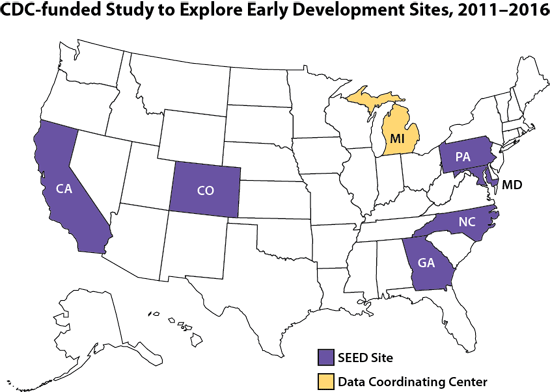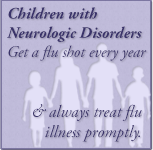Research
On This Page
Determining How Many People Have Developmental Disabilities— Tracking
By studying the number of people identified with a developmental disability at different points in time, we at the Centers for Disease Control and Prevention (CDC) can find out if the number is rising, dropping, or staying the same. We also can compare the number of children with developmental disabilities in different areas of the country and among different groups of people, such as girls and boys, and children in different racial and ethnic groups. This information can help direct our research into potential risk factors and causes and can help communities direct their outreach efforts to those who need it most.

The Importance of Tracking
Through CDC’s work in tracking developmental disabilities over the past 20 years, more is known about which children are more likely to have developmental disabilities, at what age they are likely to be diagnosed, and whether progress has been made in early identification of children with developmental disabilities. This is the information communities need to plan for services and understand where improvements can be made to help these children. On a national scale, CDC’s work on developmental disabilities is guiding critical research and informing programs and policies.
Following are activities that CDC conducts or funds in order to learn more about developmental disabilities.
ADDM Fact Sheet
Autism and Developmental Disabilities Monitoring (ADDM) Network
To get a better picture of the scope of autism spectrum disorder (ASD) in the United States, the Children’s Health Act of 2000 authorized CDC to create the Autism and Developmental Disabilities Monitoring (ADDM) Network. The ADDM Network is a group of programs funded by CDC to estimate the number of children with autism spectrum disorder (ASD) and other developmental disabilities living in different areas of the United States. The ADDM Network currently monitors ASD, cerebral palsy, and intellectual disability, and is the largest multisite collaboration monitoring these conditions in the United States.
The ADDM Network sites all collect data using the same method, which is modeled after the method used by CDC’s Metropolitan Atlanta Developmental Disabilities Surveillance Program (MADDSP). Each ADDM Network site is made up of a geographic region within a state. The ADDM Network site tracks the number and characteristics of 8-year-old children who live in that geographic region.
The ADDM Network uses a two-stage, records-based tracking method. First, trained abstractors review and abstract detailed information from health and education records at multiple sources that evaluate and provide services to children with developmental disabilities. The abstracted information from all sources for a given child is then reviewed by trained clinicians. These trained clinicians determine if the child meets the criteria for one or more of the developmental disabilities that the ADDM Network tracks.
The goals of the ADDM Network are to:
- Provide data about how common ASD and other developmental disabilities are in a specific place and during a specific time period (also known as prevalence).
- Describe the population of children with ASD and other developmental disabilities.
- Identify changes in the occurrence of ASD and other developmental disabilities over time.
- Understand the impact of ASD and other developmental disabilities in US communities.
Current ADDM Network Activities:
- The ADDM Network is now in its third phase of funding. Currently there are 12 ADDM Network sites monitoring the prevalence of ASD among 8-year-old children living in these communities during 2010.
- CDC also has provided supplemental funding to six ADDM Network sites to monitor the prevalence of ASD among younger children (4-year-olds) using ADDM Network methods. These efforts will increase our understanding of the characteristics and early identification of younger children with ASD.
- Some ADDM Network sites also study the prevalence of other developmental disabilities, including cerebral palsy, intellectual disability, hearing loss, and vision impairment.
Understanding the characteristics and number of children who have ASD and other developmental disabilities is key to promoting awareness of the condition, helping educators and providers to plan and coordinate service delivery, and identifying important clues for future research.
Learn more about the conditions that the ADDM Network tracks:
Read the ADDM Network prevalence reports and other publications »
Metropolitan Atlanta Developmental Disabilities Surveillance Program (MADDSP)
CDC’s Metropolitan Atlanta Developmental Disabilities Surveillance Program (MADDSP) estimates the number of children with selected developmental disabilities in the metropolitan Atlanta area. CDC began tracking the prevalence of intellectual disability, cerebral palsy, hearing loss, vision impairment, and epilepsy among children 10 years of age in 1984 as part of the Metropolitan Atlanta Developmental Disabilities Study (MADDS). The success of that study prompted CDC to establish MADDSP in 1991 to identify children in the metropolitan Atlanta area who had one or more of four developmental disabilities—cerebral palsy, hearing loss, intellectual disability, and vision impairment. Autism spectrum disorder (ASD) were added to the program in 1996. MADDSP served as the model for the creation of the Autism and Developmental Disabilities Monitoring (ADDM) Network and, since 2000, has participated as one of the sites in the ADDM Network.
MADDSP has contributed a wealth of information on the characteristics of children with developmental disabilities and changes in prevalence over time. In addition, by linking with other datasets, MADDSP has examined a range of risk factors, costs, and resource needs associated with developmental disabilities.
Learn more about MADDSP »
Learn more about MADDS »
National Surveys
CDC conducts nationally representative surveys that provide data on the health of children in the United States: the National Health and Nutrition Examination Survey (NHANES) III and the National Health Interview Survey (NHIS). These surveys include information on developmental disabilities and delays.
Learn more about NHANES »
Learn more about NHIS »
CDC also collaborates on the development and management of other nationally representative surveys sponsored by the Maternal and Child Bureau of the U.S. Health Resources and Services Administration: the National Survey of Children’s Health (NSCH) and the National Survey of Children with Special Health Care Needs (NSSHCN). These surveys also provide data on children’s health and development.
Learn more about NSCH »
Learn more about NSCSHCN »
CDC has used data from these national surveys to conduct a range of studies on the prevalence of developmental disabilities, demographic characteristics of children with developmental disabilities, health and health care needs of children with developmental disabilities, and family impacts of parenting a child with special needs.
Read publications that used national surveys »
Brick Autism Project (Project Completed)
In late 1997, a citizen’s group in Brick Township, New Jersey, told the state Department of Health and Senior Services about what seemed to be a larger than expected number of children with autism spectrum disorder (ASD) in Brick Township. CDC and the Agency for Toxic Substances and Disease Registry (ATSDR) worked together to find out how common ASD were in Brick Township and to study the possible relationship of environmental factors to ASD in the community.
The prevalence of ASD in Brick Township was 6.7 per 1,000 children. This was higher than prevalence estimates from other studies conducted at that time, particularly studies conducted in the United States. However, the prevalence of ASD in Brick Township was within the range of studies that used more thorough case-finding methods among smaller populations.
Read publications and reports from the Brick Autism Project »
Understanding Risk Factors and Causes—Research
CDC supports public health research, including studying potential causes of developmental disabilities. Both public health tracking and research efforts provide information necessary to direct prevention efforts.
Following are some of the research programs that CDC is conducting or has been involved in.
SEED Fact Sheet
Study to Explore Early Development (SEED)
SEED is currently the largest study in the United States to help identify factors that might put children at risk for autism spectrum disorder (ASD). SEED is being conducted in diverse communities across the country. There are sites in California, Colorado, Georgia, Maryland, North Carolina, and Pennsylvania.
SEED’s main research goals are to compare young children (2 through 5 years of age) who have ASD, children who have developmental problems other than ASD, and children from the general population to better understand characteristics of ASD and genetic and environmental factors that might affect child development. In SEED, the environmental factors we study are very broad and include characteristics of the pregnancy, the birth and newborn period, and the first few years of life to see what might affect a child’s risk of having an ASD. A key strength of SEED is its ability to look at detailed information on the characteristics of ASD and at environmental and genetic factors at the same time to see how they all interact.
The information is obtained by directly evaluating the children using several established developmental instruments and procedures, conducting interviews with the mothers, reviewing medical records, and collecting saliva and blood samples from the children and their parents.

Learn more about SEED »
Learn more about the Georgia SEED site »
The CDC–Denmark Program (Project Completed)
The CDC–Denmark Program was set up to look at many public health issues. The program highlighted the work done using Danish national public health data systems. The Danish data systems include more than 200 long-term disease and administrative registries. These systems are linked with one another. Thus, they can be used to make data sets with information on very large numbers of people. These data sets cover long periods of time. Therefore, they can be used to look at health trends and disease traits. They also can be used to study some less common risk factors or diseases in detail.
Read publications from CDC-Denmark »
The Metropolitan Atlanta Developmental Disabilities Follow-up Study of Young Adults (Project Completed)
In the mid-1980s, CDC conducted the Metropolitan Atlanta Developmental Disabilities Study (MADDS), a study of developmental disabilities among 10-year-old children living in metropolitan Atlanta. The Metropolitan Atlanta Developmental Disabilities Follow-up Study of Young Adults contacted many of the original study participants years later, when they were young adults. They were asked questions about various subjects, such as their health, living arrangements, socialization, employment, and quality of life. This information continues to be helpful in understanding the functioning and transition of children with developmental disabilities into young adulthood.
Key Findings
Key Findings: Influenza Vaccination in Children with Neurologic or Neurodevelopmental Disorders
A new study looking at the influenza (flu) vaccination practices of parents and healthcare providers who provide care for Children with Neurologic or Neurodevelopmental Disorders (NNDDs).
(Published September 10, 2015)
Key Findings: Developmental Disabilities Trends
Trends in the Prevalence of Autism Spectrum Disorder, Cerebral Palsy, Hearing Loss, Intellectual Disability, and Vision Impairment, Metropolitan Atlanta, 1991-2010
(Published June 1, 2015)
Key Findings: Women’s Weight Before Pregnancy and Child Development
Pediatrics has published a new study looking at the relationship between a woman’s weight before pregnancy and her child’s development.
(Published: April 27, 2015)
Key Findings: Prevalence of cerebral palsy, co-occurring autism spectrum disorders, and motor functioning
Developmental Medicine and Child Neurology journal has published a new study: “Prevalence of Cerebral Palsy, Co-Occurring Autism Spectrum Disorders, and Motor Functioning – Autism and Developmental Disabilities Monitoring Network, USA, 2008.”
(Published: October 23, 2013)
Key Findings: Are children with neurologic or neurodevelopmental conditions being vaccinated for the flu?
In a new study published in the Morbidity and Mortality Weekly Report, parents and doctors were surveyed to find out if children with neurologic or neurodevelopmental conditions were being vaccinated for the flu.
(Published: September 13, 2013)
Key findings: Childhood vision impairment, hearing loss and co-occurring autism spectrum disorder
The Disability and Health Journal has published a new study
(Published: July 29, 2013)
Key Findings: Flu Deaths in Children
Children with neurologic disorders at higher risk.
(Published: August 29, 2012)
Key Findings: Trends in the Prevalence of Developmental Disabilities
This study determined the prevalence of developmental disabilities in U.S. children and in selected populations for a 12-year period.
(Published: May 24, 2011)
- Page last reviewed: April 21, 2017
- Page last updated: July 29, 2016
- Content source:



 ShareCompartir
ShareCompartir
